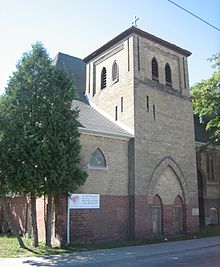St. Bartholomew's Anglican Church (Toronto)
| St Bartholomew's, Regent Park | |
|---|---|

St Bartholomew's Church in Regent Park
|
|
| Denomination | Anglican Church of Canada |
| Churchmanship | Anglo-Catholic |
| Website | http://www.stbartstoronto.ca/ |
| History | |
| Dedication | Saint Bartholomew |
| Administration | |
| Deanery | St James |
| Diocese | Toronto |
| Province | Ontario |
| Clergy | |
| Vicar(s) | The Rev'd Dr Walter Hannam |
| Priest in charge | The Very Rev'd Andrew Asbil |
St. Bartholomew's Anglican Church (better known as St Bartholomew's, Regent Park) is a parish of the Diocese of Toronto in the Anglican Church of Canada. It is a ministry in collaboration with St James Cathedral.
Located in Regent Park, Toronto, the congregation operates several outreach programmes. It is an Anglo-Catholic parish maintaining 'Full Catholic Privileges'.
St Bartholomew's was founded in 1873 as a mission of All Saints, Sherbourne Street, and, until 1910, stood at the end of Beech Street (now Dundas Street East) on the east side of River Street. The parish of St Matthew's, Riverdale, in its turn, began life as a mission of St Bartholomew's in 1874. A second mission church, St Augustine's, was established on the corner of Spruce and Parliament streets in Cabbagetown in 1888. It became and independent parish in 1905 and was destroyed by fire in 1931.
The parish church was moved to its present location on the corner of Dundas and Regent Streets in 1910 to make way for the Dundas Street bridge. While numbers and finances declined just before and during the First World War, two lay guilds, the St Bartholomew's Association (a parish society for the advancement of the spiritual life) and a chapter of the Brotherhood of St Andrew, appear to have flourished.
Unlike certain other Toronto parishes of the same era, such as St Mary Magdalene's, St Thomas's, Huron Street, and St Matthias, Bellwoods, St Bart's was not an Anglo-Catholic foundation. The first Anglo-Catholic rector of St Bartholomew's was Father Charles Fredrick Pashler. A veteran of the First World War, who had been severely wounded at Monchy in August of 1918, Father Pashler was influenced not only by the Tractarian and Ritualist movements of the Church of England, but also by the simple Roman Catholic piety he had witnessed in rural France: "the kindliness and unaffected piety of the people, the natural practice of their religion, the soutane-clad figures of their pastors in the village streets and country lanes" were all to have their influence on his ministry. Pashler was "unique among Toronto priests" of his generation "inasmuch as he always and everywhere wore his cassock, in and out of season" (a common practice on the Continent and in Anglo-Catholic parishes in England at the time).
...
Wikipedia
